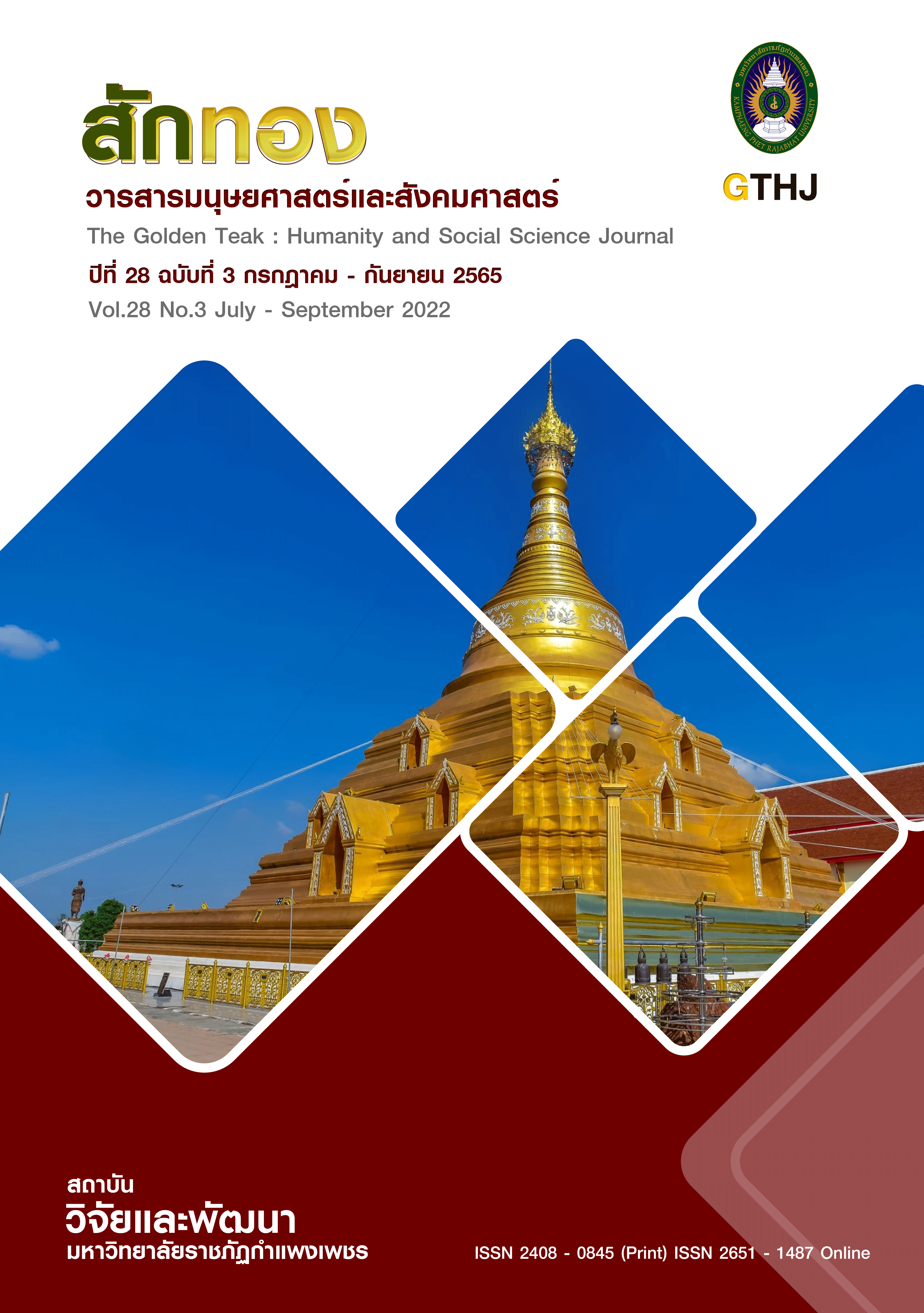INSTRUCTIONAL GUIDELINE FOR USING 5 PRACTICES TO PROMOTE MATHEMATICAL DISCUSSIONS ON PERCENTAGE OF FIFTH GRADE
Main Article Content
Abstract
The objectives of the study were : 1. to synthesize instructional guidelines for promoting classroom mathematical discussion according to 5 practices. 2. to examine students’ behaviors in classroom mathematical discussion in a Percentage lesson for fifth grade students of a school in Nakornsawan province. Four cycles of action research were conducted in 10 hours. Research tools of this study included four lesson plans, four worksheets, an instructional reflection form, a video recording, and a mathematical discussion observation form. As a result, 1. four instructional guidelines were synthesized and reported including 1) preparing guideline for pre and during instruction; 2) guideline for stimulating students and creating common understanding on the problem; 3) guideline for creating and maintaining discussion vibe; 4) guideline for connecting and forming mathematical ideas and concept. 2. indicates a positive trend of participation in the classroom mathematical discussion. Connecting, arguing and reasoning as well as explaining are the most prevalent actions of students found in this study. Most of the students' discussions related to steps and procedures in solving problems.
Article Details

This work is licensed under a Creative Commons Attribution-NonCommercial-NoDerivatives 4.0 International License.
บทความที่ได้รับการตีพิมพ์เป็นลิขสิทธิ์ของวารสาร สักทอง : วารสารมนุษยศาสตร์และสังคมศาสตร์ สถาบันวิจัยและพัฒนา มหาวิทยาลับราชภัฏกำแพงเพชร
ข้อคิดเห็นใดๆ ที่ปรากฎในวารสารเป็นวรรณกรรมของผู้เขียนโดยเฉพาะ ซึ่งมหาวิทยาลัยราชภัฏกำแพงเพชรและบรรณาธิการไม่จำเป็นต้องเห็นด้วย
References
Boaler, J. (2008). What’s math go to do with it? Helping children learn to love their most hated subject—And why it’s important for America. New York, NY : Viking.
Buason, R. (2013). Qualitative research of education. Bankok : V. PRINT (1991) COMPANY LIMITED.
Calgary Board of Education. (2018). Mathematical Discussion. [Online]. Available : https://school.cbe.ab.ca/School/Repository/SBAttachments/6832ff4e-3eb1-4c47-9958-0ef422158842_Mathematical-Discussions.pdf [2021, January 3].
EDUCA. (2020). ใจพร้อม กายพร้อม เราเรียนได้. [Online]. Available: https://www.educathai .com/knowledge/articles/374 [2021, April 25].
Erath, K., Prediger, S., Quasthoff, U. & Heller, V. (2018). Discourse competence as important part of academic language proficiency in mathematics classrooms : the case of explaining to learn and learning to explain. [Online]. Available : https://doi.org/10.1007/s10649-018-9830-7 [2020, October 23].
Hiebert, J., Carpenter, T.P., Fennema, E., Fuson, K. C., Wearne, D., Murray, H. & Human, P. (1997). Making sense: Teaching and learning mathematics with understanding. Portsmouth, NH : Heinemann.
Ponte, J.P., Quaresma, M. & Mata-Pereira, J. (2017). The challenge of mathematical discussions in teachers'professional practice. [Online]. Available : https://www. researchgate.net/publication/327106520_The_challenge_of_mathematical_discussions_in_ teachers%27_professional_practice [2021, April 26].
Karl W. Kosko. (2012) The Effect of Student Discussion Frequency on Fifth-Grade Students’Mathematics Achievement in U.S. Schools. [Online]. Available : https://www.researchgate.net/publication/257491289_Students%27_Quality_of_ Mathematical_Discussion_and_Their_Self-Determination_in_Mathematics [2020, October 30].
Larsson, M. (2015). Orchestrating mathematical whole-class discussions in the problem solving classroom : Theorizing challenges and support for teachers. Sweden : Mälardalen University.
National Council of Teacher of Mathematics. (2009). Focus in high school mathematics: Reasoning and sense making. Reston, VA : National Council of Teachers of Mathematics.
National Council of Teachers of Mathematics. (2013). What Does Research Say the Benefits of Discussion in Mathematics Class Are?. [Online]. Available : https://projects.ias.edu/pcmi/outreach/southborough/WhatDoesResearchSay theBenefitsofDiscussioninMathematicsClassArearticleModule2PCMITtSCWorkshop.pdf [2021, January 20].
National Research Council. (2002). Adding it up: Helping children learn mathematics. J. Kilpatrick, J. Swafford, J., & B. Findell (Eds.). Mathematics Learning Study Committee, Center for Education, Division of Behavioral and Social Sciences and Education. Washington, DC: National Academy Press.
Polya, G. (1945). How to solve it. Princton : Princeton University Press.
Stein, M.K., Engle, R.A., Smith, M.S. & Hughes, E.K. (2008). Orchestrating productive mathematical discussions: Five practices for helping teachers move beyond show and tell. Mathematical Thinking and Learning, 10(4), 313-340.
Sutida, K. (2004). Effects of using communication process on mathematics learning achievement and achievement motivation towards mathematics of lower secondary school students. Master’s thesis, Chulalongkorn University.
Thachinee, S. (2019). Mathematical Argumentation in Classroom Using Lesson Study and Open Approach. The 20th National Graduate Research Conference(pp.1873-1883). Khon Kaen : Khon Kaen University.
Thassamon, W. (2018). Effects of organizing mathematics learning activities using stein’s model on mathematical knowledge and reasoning ability of ninth grade students. Master’s thesis, Chulalongkorn University.
The Institute for the Promotion of Teaching Science and Technology. (2012). Professional Mathematics Teacher The road to success. Bangkok : 3-Q Media.


